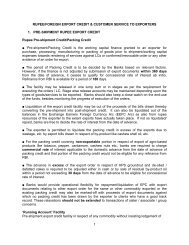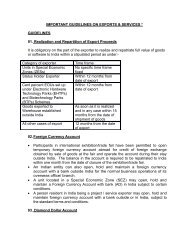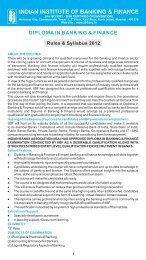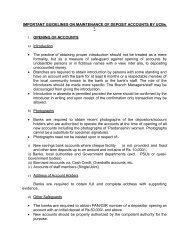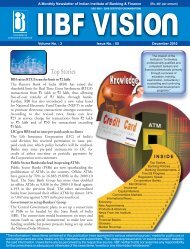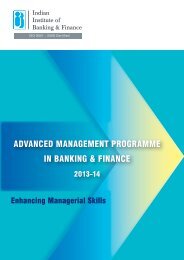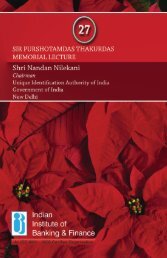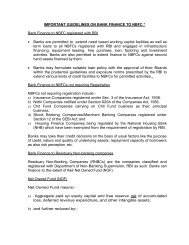special featureJuly 1997. It focuses on the mandated aspects ofsolvency, liquidity, financial and operational health,based on modified version of CAMEL model, viz.CAMELS, which evaluates banks' Capital Adequacy,Asset Quality, Management, Earnings, Liquidity andSystems and Control, shedding the audit elementsunder the existing inspection system. (Bodla andVerma, 2006).In 1995, Padmanabhan working group submitted itsreport on On-site supervision. The recommendationsincluded supervisory interventions along withformulation of a rating system for banks similar toCAMEL model, customized for Indian conditions(Bodla, Ibid). Narsimham Committee (1998) alsorecommended measures like introduction of IRACnorms along with provisioning and capital adequacy.RBI recognizes CAMEL ratings as an appropriatetechnique for evaluating the performance of banks.Ratings are assigned for each component on ascale of 1 to 5. The worst rating is 5, which meansthat a bank is in imminent danger of failure. Aggregaterating is the sum total of the ratings under all thefive components. These ratings, ranging from 1 to 5,are described as 'Strong', 'Satisfactory', 'Fair', 'Marginal'and 'Unsatisfactory', in the same order (Mittal andDhade, 2009).CAMEL is essentially a diagnostic tool for detectingpotential problems in banking sector. The objective isthat banks conduct a critical self-analysis of thefinancials and a subsequent review by their boardsfor health-check. Further, this analysis is sent to RBIas a supplement to the system of off-site monitoringof banks. An efficient result oriented on-site inspectionsystem requires an efficient follow-up. Thus thepresent supervisory system in banking sector is asubstantial improvement over the earlier system interms of frequency, coverage and focus as also thetools employed. Nearly one-half of the Basle CorePrinciples for Effective Banking Supervision hasalready been adhered to and the remaining is at astage implementation. These ratings would enable theRBI to identify the banks whose conditions warrantsspecial supervisory attention (Bodla, Ibid).We may draw upon the following literature for developinga conceptual framework.Sathye (2005) tried to assess the efficiency ofbanks post-privatization. Satish, Jutur, Sharath andSurender (2005) also used CAMEL model forperformance assessment of Indian Banks. Theyanalyzed the performance of 55 banks for the year2004-05 using CAMEL model. The findings pointedtowards soundness of the Indian Banking systemand need for adoption of latest IT tools for future.They also highlighted imminent plans of Bank's IPOsfor augmenting Tier-1 capital in line with Basel-2 norms.Prasuna (2004) analyzed the performance 65 banksfor the period 2003-04 adopting CAMEL model. Theauthor highlighted that owing to heightened competition,customers were getting better service quality, innovativeproducts, and better bargains. They also highlightedthe need for banks to realign their strategic focus inview of transition phase towards imminent firming up ofinterest rates.Veni (2004 as cited by Bodla, Ibid) studied the capitaladequacy of banks and the measures adopted by themto strengthen it. The author highlighted that the ratingagencies give weightage to Capital Adequacy Ratios ofbanks while rating the Bank's certificate of deposits, fixeddeposits and bonds. They normally adopt CAMEL modelfor rating of banks. Thus capital adequacy is considereda key element in Bank Rating.Kumbhakar and Sarkar (2003) also tried to assessderegulation, ownership and productivity growth inIndian banking. Kick and Koetter (2003) tried to assessthe probability of ordered failure events in GermanBanks using CAMEL model. Barr; Seiford and Siems(1993) attempted to study 930 banks over a five yearperiod to search for leading indicators for predictingbank failures in US. They attempt to quantify themanagerial efficiency (“M” of CAMEL), citing it as keyin bank performance. For, they used a multi-dimensionaldata-envelopment-analysis (DEA) model. They foundthat differences in “M” scores are detectable longbefore failure occurs and increase as the failure dateapproaches.44October - December 2011The Journal of Indian Institute of Banking & Finance
special featureGodse (1996) also studied CAMEL for evaluatingperformance of banks.Rao and Dutta (1998, cited by Bodla, Ibid) attempted toderive rating based on CAMEL. In their study, based onthese five groups (C-A-M-E-L-S), 21 parameters in allwere developed. After deriving separate rating foreach parameter, a combined rating was derived forall nationalized banks (19) for the year 1998.It wasfound that the worst rating was that of Indian Bankpreceded by UCO Bank, United Bank of India, SyndicateBank and Vijaya Bank.On making review of previous studies, we conclude thatthey used CAMEL model for ranking / rating of the banks.In this light we propose to make a comparative studyof performance of public sector and private sector banksin India.DATA & METHODOLOGYThe period of study in this paper is financial yearending March 31, 2010. The data has been collectedfrom Annual Reports of the Banks and CMIE PROWESSdatabase.There are total 55 scheduled commercial banks inIndia (www.rbi.org.in). Out of this 28 are in publicsector and 27 are in private sector. The populationis too small to permit sampling. Therefore, entirepopulation has been considered. However, sincesome of these banks are not yet a public limitedcompany, their financial data is not available inpublic domain. Therefore, 26 public sector banksand 22 private sector banks, whose data wasavailable in CMIE PROWESS database, constituteour population.The CAMEL model has been used as a measuringinstrument to capture the performance of variousbanks. The difference of means test and t-statistichas been used on the significance of difference ofresults of these banks on various parameters ofperformance as obtained by CAMEL model.The CAMEL model is described as under :CAMEL is a ratio-based model for evaluating theperformance for banks. Various ratios forming thismodel are as follows :C A M E LCapitalAdequacyAdvancesto AssetsCapitalAdequacyRatioDebtEquityRatioG-Secto totalInvestmentsAssetQualityGrossNPA toNetAdvancesNet NPAto NetAdvancesNet NPAto TotalAssetsTotalInvestmentto TotalAssetsCapital Adequacy:ManagementEfficiencyBusinessPerEmployeeProfit PerEmployeeTotalAdvancesto TotalDepositsEarningsQualityInterestIncometo TotalIncomeNet Profitto AverageAssetsNon-interestIncometo TotalIncomeOperatingProfits toAverageWorkingFundsSpreadto TotalAssetsLiquidityG-Secto TotalAssetsLiquidAssets toDemandDepositsLiquidAssetsto TotalAssetsLiquidAssetsto TotalDepositsBanks must maintain depositor's confidence andprevent bankruptcy. Capital serves as a cushionto absorb unexpected performance shocks andinspires depositors' confidence while denotingstability and efficiency of financial system. Capitaladequacy represents the overall financial conditionand ability of the management to raise additionalcapital. Capital Adequacy Ratio indicates degree ofbank leverage. It's measurement is done by :1. Capital Adequacy Ratio :The banks are required to maintain the minimumCAR as specified by RBI from time to time, whichcurrently stands at 9%. It is arrived at by dividing thesum of Tier-1 and Tier-2 capital by aggregate ofRisk Weighted Assets (RWA).CAR= (Tier-1 + Tier-2)/ RWATier-1 capital includes equity capital and freereserves.Tier-2 capital includes subordinate debts of5-7 years tenure, revaluation reserves, generalprovisions and loss reserves, hybrid debt capitalThe Journal of Indian Institute of Banking & Finance October - December 2011 45



